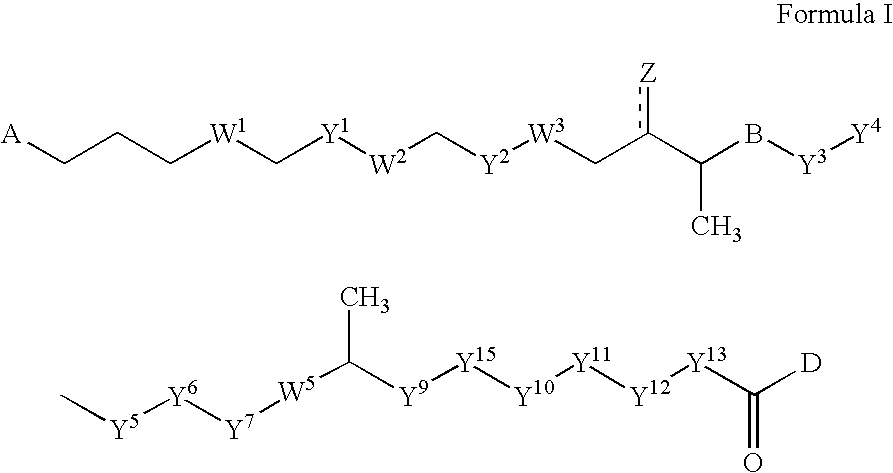Polyene polyketides, processes for their production and their use as a pharmaceutical
a technology of polyene polyketide and polyethylene, applied in the field of polyene polyketide, can solve the problems of cost and time-consuming, modification of existing compounds, and limited availability of compounds
- Summary
- Abstract
- Description
- Claims
- Application Information
AI Technical Summary
Benefits of technology
Problems solved by technology
Method used
Image
Examples
example 1
Production of Compound 2(a) by Fermentation
EXAMPLE 1(A)
Preparation of Strain [C03U03]023
[0261] Strain [C03]023: Streptomyces aizunensis NRRL B-11277 was plated on three tomato paste oatmeal agar (ATCC medium 1360) plates for sporulation at 28° C. The plates were incubated for a period of 5-7 days, after which spores were collected from each plate into 5 ml sterile distilled water, spun down by centrifugation at 5000 rpm (10 min), and dispersed in 20 ml sterile water. After a second centrifugation under the same conditions the pellet was resuspended in 10 ml sterile distilled water. A series of ten-fold dilutions of the original spore suspension were prepared and 0.5 ml aliquots plated on tomato paste-oat meal agar until sporulation occurred (5-7 days). Each individual clone from the plates with single well-isolated colonies (generated from 10−8 to 10−10 dilutions of the spore suspension) was chosen and transferred to one plate of tomato paste-oat meal agar to generate spores for ...
example 1 (
EXAMPLE 1(E)
Production of Compound 2(a) by Fermentation
[0266] A sample of the seed culture prepared as described in Example 1(D) above was checked microscopically for any possible contamination. A sample of the seed culture was then streaked onto one ISP2 plate (control plate) and incubated at 28° C. From the seed culture under aseptic conditions, 10 ml was taken and used to inoculate each 2 Liter baffled flask containing 500 ml of sterile medium QB or VA. The fermentation batches were incubated aerobically with shaking (250 rpm) at 28° C. for a period of 7 days. After 3-5 days of incubation the control plate was checked for purity of the culture.
[0267] The compositions of the growth media used in Examples 1(A) -1(E) are given below. Note that either of Production media QB or VA may be used in the production of Compound 2(a); however, production medium VA is preferred when conducting the fermentation on a large scale.
Seed Medium ITSB:Trypticase Soy Broth (Difco)30gYeast extract ...
example 2
Isolation of Compound 2(a)
[0269] Thirty minutes prior to harvest of Compound 2(a) from the fermentation broth of the baffled flasks of Example 1 E, regenerated, water-washed, Diaion HP-209 in a quantity of wet-packed volume equal to 12% of the initial fermentation beer volume was added to the whole fermentation broth of Example 1E and modest agitation was continued for 30 minutes. At harvest the fermentation broth from 2×500 ml flasks was centrifuged and the supernatant was decanted from the resin and mycelia pellet. The pellet was resuspended in 15% MeOH in water (half the original fermentation beer volume), agitated mildly and recentrifuged, and the surpernatant was decanted from the residue. The residue was washed a second time in the same manner with another 15% MeOH in water, followed by a single final wash with methanol:water (7:3 v / v) (half the original fermentation beer volume) to obtain a well-washed residue. The well-washed mycelia:resin residue was extracted three times ...
PUM
| Property | Measurement | Unit |
|---|---|---|
| Time | aaaaa | aaaaa |
| Strain point | aaaaa | aaaaa |
Abstract
Description
Claims
Application Information
 Login to View More
Login to View More - R&D
- Intellectual Property
- Life Sciences
- Materials
- Tech Scout
- Unparalleled Data Quality
- Higher Quality Content
- 60% Fewer Hallucinations
Browse by: Latest US Patents, China's latest patents, Technical Efficacy Thesaurus, Application Domain, Technology Topic, Popular Technical Reports.
© 2025 PatSnap. All rights reserved.Legal|Privacy policy|Modern Slavery Act Transparency Statement|Sitemap|About US| Contact US: help@patsnap.com



